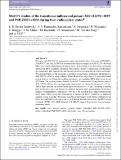Files in this item
Mid-UV studies of the transitional millisecond pulsars XSS J12270-4859 and PSR J1023+0038 during their radio pulsar states
Item metadata
| dc.contributor.author | Rivera Sandoval, L. E. | |
| dc.contributor.author | Hernández Santisteban, J. V. | |
| dc.contributor.author | Degenaar, N. | |
| dc.contributor.author | Wijnands, R. | |
| dc.contributor.author | Knigge, C. | |
| dc.contributor.author | Miller, J. M. | |
| dc.contributor.author | Reynolds, M. | |
| dc.contributor.author | Altamirano, D. | |
| dc.contributor.author | van den Berg, M. | |
| dc.contributor.author | Hill, A. | |
| dc.date.accessioned | 2019-09-10T16:30:04Z | |
| dc.date.available | 2019-09-10T16:30:04Z | |
| dc.date.issued | 2018-05 | |
| dc.identifier | 261035158 | |
| dc.identifier | f2ace8ef-3ca4-40dc-aa95-38f53e6a0253 | |
| dc.identifier | 85043496919 | |
| dc.identifier.citation | Rivera Sandoval , L E , Hernández Santisteban , J V , Degenaar , N , Wijnands , R , Knigge , C , Miller , J M , Reynolds , M , Altamirano , D , van den Berg , M & Hill , A 2018 , ' Mid-UV studies of the transitional millisecond pulsars XSS J12270-4859 and PSR J1023+0038 during their radio pulsar states ' , Monthly Notices of the Royal Astronomical Society , vol. 476 , no. 1 , pp. 1086-1099 . https://doi.org/10.1093/mnras/sty291 | en |
| dc.identifier.issn | 0035-8711 | |
| dc.identifier.other | BibCode: 2018MNRAS.476.1086R | |
| dc.identifier.other | ORCID: /0000-0002-6733-5556/work/61370234 | |
| dc.identifier.uri | https://hdl.handle.net/10023/18451 | |
| dc.description.abstract | We report mid-UV (MUV) observations taken with Hubble Space Telescope (HST)/WFC3, Swift/UVOT, and GALEX/NUV of the transitional millisecond pulsars XSS J12270−4859 and PSR J1023+0038 during their radio pulsar states. Both systems were detected in our images and showed MUV variability. At similar orbital phases, the MUV luminosities of both pulsars are comparable. This suggests that the emission processes involved in both objects are similar. We estimated limits on the mass ratio, companion's temperature, inclination, and distance to XSS J12270−4859 by using a Markov Chain Monte Carlo algorithm to fit published folded optical light curves. Using the resulting parameters, we modelled MUV light curves in our HST filters. The resulting models failed to fit our MUV observations. Fixing the mass ratio of XSS J12270−4859 to the value reported in other studies, we obtained a distance of ∼3.2 kpc. This is larger than the one derived from dispersion measure (∼1.4 kpc). Assuming a uniform prior for the mass ratio, the distance is similar to that from radio measurements. However, it requires an undermassive companion (∼0.01M⊙). We conclude that a direct heating model alone cannot fully explain the observations in optical and MUV. Therefore, an additional radiation source is needed. The source could be an intrabinary shock which contributes to the MUV flux and likely to the optical one as well. During the radio pulsar state, the MUV orbital variations of PSR J1023+0038 detected with GALEX, suggest the presence of an asymmetric intrabinary shock. | |
| dc.format.extent | 3103806 | |
| dc.language.iso | eng | |
| dc.relation.ispartof | Monthly Notices of the Royal Astronomical Society | en |
| dc.subject | Stars: neutron | en |
| dc.subject | Pulsars: general | en |
| dc.subject | Pulsars: individual: XSS J12270-4859 | en |
| dc.subject | Pulsars: individual: PSR J1023+0038 | en |
| dc.subject | Ultraviolet: stars | en |
| dc.subject | X-rays binaries | en |
| dc.subject | QB Astronomy | en |
| dc.subject | QC Physics | en |
| dc.subject | DAS | en |
| dc.subject.lcc | QB | en |
| dc.subject.lcc | QC | en |
| dc.title | Mid-UV studies of the transitional millisecond pulsars XSS J12270-4859 and PSR J1023+0038 during their radio pulsar states | en |
| dc.type | Journal article | en |
| dc.contributor.institution | University of St Andrews. School of Physics and Astronomy | en |
| dc.identifier.doi | https://doi.org/10.1093/mnras/sty291 | |
| dc.description.status | Peer reviewed | en |
| dc.identifier.url | https://arxiv.org/abs/1708.07041 | en |
| dc.identifier.url | http://adsabs.harvard.edu/abs/2018MNRAS.476.1086R | en |
This item appears in the following Collection(s)
Items in the St Andrews Research Repository are protected by copyright, with all rights reserved, unless otherwise indicated.

